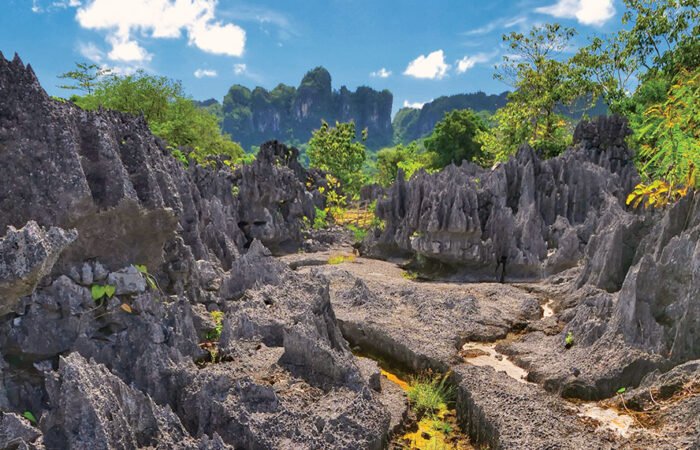The existence of prehistoric caves in Pangkep is an evidence that in a distant period, has emerged a human civilization that became the umbilical cord from which the present comes
Word: Ayu Arman
Clusters of rocky (karst) mountain backs in Pangkajene Islands District, South Sulawesi, line up like a series of puzzle boards. They are in an orderly shape, forming niches, valleys, and steep cliffs. There are hundreds of caves filled with drawings of hand prints, human anatomy, pottery remains, stone tools, sea shells, to animal bones.
The number of caves which have archaeological remains in this Pangkep karst reaches hundreds of various caves. There are hundreds of meters depth caves, some are vertical. These caves have their own charm. They become a storehouse of science to determine the long journey of Sulawesi people.
Therefore, if you travel from Makassar to Pangkajene dan Kepulauan District, along the way you will enjoy the landscape of Maros-Pangkep karst area, in addition to paddy fields and fish ponds.

Maros-Pangkep karst is the most unique landscape, which is not found in other karst areas in Indonesia and the world. Here, the karst is generally in conical hills shape.
The Pangkep karst is in tower shape that stand alone or in groups to form clusters of towering limestone mountains.
Among the towering hills, lies a terrain with a flat surface. There are very few places in the world which have such stone tower hills.
You can only find the typical karst tower of Maros-Pangkep in South China and Halong Bay Vietnam. Maros-Pangkep karst is also the second largest and most beautiful area in the world after China. In fact, the longest and deepest cave in Indonesia is found here.
Based on the identification of the National Archaeological Center, the prehistoric caves in Maros-Pangkep region amounted to 117, and 43 caves are included in the area of Bulusaraung National Park with the findings of paintings, artifacts, ecofacts, and shells (kitchen waste). Pangkep prehistoric cave sites are scattered in the foot of limestone cliffs stretching to the east of the district capital.

Based on the results of 2010 data collection conducted by the government of Pangkep Regency, it is known that the caves are included in four different sub-districts, namely 5 caves in Labakkeng, 8 caves in Bungoro, 22 caves in Pangkajene, and 2 caves in Balocci.
Since 2017, the karst area and prehistoric caves of Pangkep have been crowned as a national geopark tourist area. An area that has elements of geodiversity, biodiversity, and cultural diversity.
On our way to Pangkep City at the end of March 2018, we also climbed the Sumpang Bite Cave, Kallibbong Aloa Cave, and Karts Park in Balocci.

